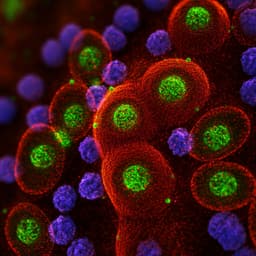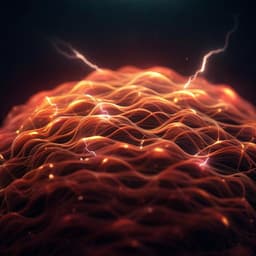
Medicine and Health
Regulating protein corona on nanovesicles by glycosylated polyhydroxy polymer modification for efficient drug delivery
Y. Miao, L. Li, et al.
Discover how glycosylated polyhydroxy polymer-modified nanovesicles can revolutionize drug delivery! This research conducted by Yunqiu Miao and colleagues reveals how specific modifications can suppress immunoglobulin adsorption, leading to prolonged circulation and enhanced tumor targeting. A fresh strategy in nanocarrier design awaits you!
~3 min • Beginner • English
Introduction
Nanocarriers acquire a dynamic protein corona in biological fluids that dictates their biological identity, influencing immune recognition, biodistribution, and cellular uptake. PEGylation reduces nonspecific adsorption but cannot fully prevent immune opsonization and can trigger anti-PEG antibodies leading to accelerated blood clearance upon repeat dosing. Hydrophilic polymer coatings can also hinder target cell uptake. This study asks whether tuning surface functional group composition—specifically the ratio and spatial arrangement of amino and hydroxyl groups on glycosylated polyhydroxy polymer-modified lipid nanovesicles—can regulate dynamic protein corona formation across physiological environments to simultaneously minimize immune opsonization and enhance tumor cell internalization, thereby improving drug delivery efficacy.
Literature Review
Prior work shows surface chemistry strongly influences protein adsorption on nanocarriers, with PEG and related polyhydroxy polymers widely used to reduce fouling but susceptible to anti-PEG antibody-mediated ABC effects. Strategies to harness coronas for targeting (e.g., transferrin adsorption) and the role of cationic polymers in enhancing uptake have been reported. Amino and hydroxyl groups participate in hydrogen bonding and can modulate hydrophilicity and protein interactions; amino acid-inspired modifications were shown to affect coronas and in vivo fate. Despite advances, a gap remains in precisely modulating functional protein interactions on nanosurfaces to avoid immune-associated proteins while promoting target cell-related protein adsorption.
Methodology
- Synthesis: Glycosylated polyhydroxy polymers (CSO-g-TCP) were synthesized by grafting PEO20-PPO70-PEO20 triblock copolymers to chitosan oligosaccharide via DSC-mediated activation and amidation. Three grafting ratios (TCP:CSO = 4:1, 2:1, 1:1) yielded CSO-g-TCP4, -TCP2, -TCP1.
- Nanovesicle fabrication: CSO-g-TCP polymers were incorporated with DPPC and cholesterol via thin-film hydration and extrusion (100 nm) to form CP4-LVs, CP2-LVs, CP1-LVs. Controls: PEGylated liposomes (PEG-Lips), TCP-only modified vesicles (P-LVs), and unmodified liposomes (Lips).
- Characterization: Size/zeta (DLS), morphology (TEM), amino/hydroxyl molar ratio (Boehm titration), and spatial distribution (Tof-SIMS depth profiling). Zeta potentials were near neutral across groups.
- In vitro protein corona analysis: Incubation with plasma or liver tissue interstitial fluid (TIF); quantification by BCA; profiling by SDS-PAGE and LC-MS/MS. Specific opsonins (IgG, IgM) and albumin assessed by Western/dot blot. Dynamic adsorption studied via sequential plasma→PBS→liver TIF or plasma→PBS→tumor TIF incubations.
- Binding thermodynamics and visualization: Isothermal titration calorimetry (ITC) quantified affinities (Ka) of albumin/IgG to each nanovesicle. Confocal/STED microscopy visualized fluorescently labeled protein binding.
- Mechanistic pI analysis: Isoelectric focusing (IEF) of free proteins (IgG, CD44, OPN) and nanovesicle–protein complexes to assess electrostatic effects driven by protein isoelectric points.
- Macrophage interactions: Uptake by J774 (blood mononuclear macrophages) and primary rat Kupffer cells assessed for vesicles with different coronas (none, plasma, plasma+liver TIF; pretreated vs naïve sources) via flow cytometry/CLSM.
- In vivo corona formation: Recovery of injected DiO-labeled vesicles from mouse plasma (2 h) and liver TIF (24 h) to quantify/characterize adsorbed proteins and IgG/IgM (Western).
- Immunogenicity: Anti-PEG antibody levels measured 7 days post first injection (ELISA) in mice.
- Pharmacokinetics/biodistribution: FITC- or IR783-labeled vesicles in rats/mice, single and repeat dosing (second dose at day 7). Parameters: elimination half-life (t1/2), AUC0–48h; organ/tumor imaging (IVIS); liver section colocalization with Kupffer cells (F4/80 staining).
- Tumor models and uptake: A549 and HeLa xenografts; tumor TIF isolation; LC-MS/MS of tumor coronas; Western blot for OPN and CD44; cell uptake in A549/HeLa/HUVEC; receptor blocking with cilengitide (integrin inhibitor) and hyaluronic acid (CD44 competitor).
- Therapeutic evaluation: Paclitaxel loading (~10%); in vitro cytotoxicity (IC50) in A549/HeLa; in vivo antitumor efficacy in xenograft-bearing mice (tumor growth, survival), and safety (body weight, H&E of organs). All animal procedures approved by IACUC.
Key Findings
- Surface chemistry controls corona load: Polyhydroxy modification reduced total plasma protein adsorption by >50% vs unmodified Lips. Increasing amino density further reduced adsorption; CP1-LVs (amino/hydroxyl ≈0.4) had the lowest protein load among all groups by BCA/SDS-PAGE.
- Reduced immune opsonins: Proteomics and Western blots showed fewer immune opsonins (complements, immunoglobulins) on CP-LVs than PEG-Lips; IgG/IgM adsorption decreased with higher amino content. CP1-LVs had the lowest IgG/IgM among CP groups.
- Dynamic corona behavior: In plasma→PBS→liver TIF sequence, albumin showed adsorption–desorption–readsorption; IgG remained associated and increased after liver TIF exposure. CP1-LVs adsorbed significantly less albumin and IgG than PEG-Lips and Lips (albumin in plasma 2.4-fold lower; IgG in liver TIF 2.1-fold lower vs PEG-Lips).
- Lower binding affinities: ITC revealed exothermic binding with lower affinity for albumin than IgG overall. CP1-LVs exhibited 1.6-fold (albumin) and 1.7-fold (IgG) lower affinity than PEG-Lips, consistent with weakest fluorescence colocalization in CLSM/STED.
- In vivo coronas mirror in vitro: Recovered vesicles from plasma and liver confirmed lowest albumin (plasma) and IgG (liver) on CP1-LVs. PEG-Lips retained notable IgG in liver, indicating residual immunogenicity.
- Anti-PEG response and ABC: After first dose, anti-PEG antibody levels were markedly lower for CP-LVs than P-LVs; CP1-LVs induced 4.6-fold lower anti-PEG levels than PEG-Lips. Upon repeat dosing, PEG-Lips showed high IgG/IgM adsorption and ABC; CP1-LVs showed minimal IgG/IgM and mitigated ABC.
- Macrophage uptake: Liver TIF coronas promoted Kupffer cell uptake. CP1-LVs, benefiting from low IgG/IgM adsorption, showed reduced phagocytosis: approximately 2-fold (J774) and 8-fold (Kupffer) lower fluorescence vs PEG-Lips.
- Pharmacokinetics: Single dose—CP1-LVs exhibited an elimination half-life of 44.6 h, 2.2-fold longer than PEG-Lips. Repeat dose—CP1-LVs maintained long t1/2 (41.3 h), 3.8-fold longer than PEG-Lips (11.0 h). AUC0–48h significantly higher for CP1-LVs.
- Biodistribution: Lower liver accumulation and reduced colocalization with Kupffer cells for CP1-LVs versus PEG-Lips.
- Tumor coronas and mechanism: In tumor TIF (A549, HeLa), total protein adsorption increased vs plasma; CP1-LVs adsorbed the most tumor stromal proteins, notably osteopontin (OPN) and CD44. IEF indicated electrostatic selectivity: low-pI proteins (OPN, CD44; pI<5.5) preferentially bound amino-rich CP1-LVs, whereas high-pI IgG (~pI 8) was repelled.
- Cellular uptake and blocking: CP1-LVs with tumor coronas showed highest uptake in A549/HeLa, but not in HUVECs. Uptake inhibition by cilengitide (integrin blocker) or hyaluronic acid (CD44 competitor) reduced CP1-LV uptake (~25% each), supporting OPN–integrin and CD44-mediated entry.
- Tumor accumulation: In vivo, CP1-LVs achieved 2.6-fold (A549) and 2.2-fold (HeLa) higher tumor fluorescence than PEG-Lips; intratumoral distribution concentrated peri-nuclear.
- Therapeutic efficacy: PTX@CP1-LVs had IC50 values 9.2-fold (A549) and 4.2-fold (HeLa) lower than PTX@PEG-Lips in vitro; in vivo, PTX@CP1-LVs achieved >90% tumor growth inhibition, extended survival to at least 57 days, with no significant weight loss or organ toxicity by H&E.
Discussion
Tuning the amino/hydroxyl ratio and spatial presentation on glycosylated polyhydroxy-coated nanovesicles governs dynamic corona formation across biological milieus. CP1-LVs (amino/hydroxyl ≈0.4) minimized adsorption of immune opsonins (albumin, IgG/IgM) in blood and liver, decreasing macrophage opsonization and mitigating PEG-related ABC upon repeat dosing, thus markedly prolonging circulation. In contrast, within tumor interstitium, electrostatically favored adsorption of low-pI proteins (OPN, CD44) on CP1-LVs promoted receptor-mediated uptake through integrins and CD44, enhancing tumor cell internalization and tumor accumulation. These environment-specific corona transformations reconcile the common trade-off between long circulation and target cell uptake seen with PEGylation, demonstrating that rational control of nanosurface functional groups can dynamically bias corona composition toward desired biological outcomes.
Conclusion
This work introduces glycosylated polyhydroxy polymer-modified nanovesicles with tunable amino/hydroxyl ratios to regulate protein coronas for efficient drug delivery. CP1-LVs (amino/hydroxyl ≈0.4) suppressed immune-related protein adsorption in circulation and liver while selectively adsorbing tumor-associated proteins (OPN, CD44) in tumor TIF, leading to prolonged circulation, enhanced tumor accumulation and uptake, and superior antitumor efficacy of paclitaxel compared with PEGylated liposomes, with good biocompatibility. The findings highlight a rational surface-design principle—adjusting functional group ratios and spatial arrangement—to control corona composition in a milieu-dependent manner. Future studies could map broader protein interactomes across diverse pathologies, optimize functional group distributions, and evaluate clinical translation across multiple drug cargos and tumor models.
Limitations
Related Publications
Explore these studies to deepen your understanding of the subject.







